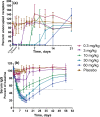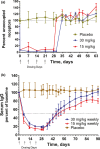M281, an Anti-FcRn Antibody: Pharmacodynamics, Pharmacokinetics, and Safety Across the Full Range of IgG Reduction in a First-in-Human Study
- PMID: 30402880
- PMCID: PMC6587432
- DOI: 10.1002/cpt.1276
M281, an Anti-FcRn Antibody: Pharmacodynamics, Pharmacokinetics, and Safety Across the Full Range of IgG Reduction in a First-in-Human Study
Abstract
M281 is a fully human, anti-neonatal Fc receptor (FcRn) antibody that inhibits FcRn-mediated immunoglobulin G (IgG) recycling to decrease pathogenic IgG while preserving IgG production. A randomized, double-blind, placebo-controlled, first-in-human study with 50 normal healthy volunteers was designed to probe safety and the physiological maximum for reduction of IgG. Intravenous infusion of single ascending doses up to 60 mg/kg induced dose-dependent serum IgG reductions, which were similar across all IgG subclasses. Multiple weekly doses of 15 or 30 mg/kg achieved mean IgG reductions of ≈85% from baseline and maintained IgG reductions ≥75% from baseline for up to 24 days. M281 was well tolerated, with no serious or severe adverse events (AEs), few moderate AEs, and a low incidence of infection-related AEs similar to placebo treatment. The tolerability and consistency of M281 pharmacokinetics and pharmacodynamics support further evaluation of M281 in diseases mediated by pathogenic IgG.
© 2018 The Authors Clinical Pharmacology & Therapeutics published by Wiley Periodicals, Inc. on behalf of American Society for Clinical Pharmacology and Therapeutics.
Conflict of interest statement
L.E.L., L.M., J.D., A.M.M., and S.A. are full‐time employees of Momenta Pharmaceuticals and may own stock or stock options. J.L.H. was an employee of Momenta Pharmaceuticals when the study was designed and conducted and subsequently a paid consultant of Momenta Pharmaceuticals and may own stock or stock options of Momenta Pharmaceuticals. N.A.C. was a full‐time employee of Momenta Pharmaceuticals during the execution of the study and subsequently a paid consultant of Momenta Pharmaceuticals, and owned stock, restricted stock, and stock options in Momenta Pharmaceuticals during manuscript preparation. R.G.T., T.B., and M.P.v.I. are full‐time employees of PRA Health Sciences and may own stock or stock options in PRA Health Sciences. D.J.N. was principal of Drug Development Consulting, currently is a full‐time employee of Certara Strategic Consulting and is a paid consultant of Momenta Pharmaceuticals. J.B.S. is principal at Streisand Biomedical Consulting and a paid consultant of Momenta Pharmaceuticals.
Figures



Similar articles
-
The FcRn inhibitor rozanolixizumab reduces human serum IgG concentration: A randomized phase 1 study.Sci Transl Med. 2017 Nov 1;9(414):eaan1208. doi: 10.1126/scitranslmed.aan1208. Sci Transl Med. 2017. PMID: 29093180 Clinical Trial.
-
M281, an anti-FcRn antibody, inhibits IgG transfer in a human ex vivo placental perfusion model.Am J Obstet Gynecol. 2019 May;220(5):498.e1-498.e9. doi: 10.1016/j.ajog.2019.02.058. Epub 2019 Mar 5. Am J Obstet Gynecol. 2019. PMID: 30849355
-
Safety, tolerability, pharmacokinetics, and pharmacodynamics of HBM9161, a novel FcRn inhibitor, in a phase I study for healthy Chinese volunteers.Clin Transl Sci. 2021 Sep;14(5):1769-1779. doi: 10.1111/cts.13019. Epub 2021 Jul 16. Clin Transl Sci. 2021. PMID: 33742786 Free PMC article. Clinical Trial.
-
Are endosomal trafficking parameters better targets for improving mAb pharmacokinetics than FcRn binding affinity?Mol Immunol. 2013 Dec;56(4):660-74. doi: 10.1016/j.molimm.2013.05.008. Epub 2013 Aug 2. Mol Immunol. 2013. PMID: 23917469 Review.
-
Neonatal Fc receptor (FcRn): a novel target for therapeutic antibodies and antibody engineering.J Drug Target. 2014 May;22(4):269-78. doi: 10.3109/1061186X.2013.875030. Epub 2014 Jan 9. J Drug Target. 2014. PMID: 24404896 Review.
Cited by
-
In Translation: FcRn across the Therapeutic Spectrum.Int J Mol Sci. 2021 Mar 17;22(6):3048. doi: 10.3390/ijms22063048. Int J Mol Sci. 2021. PMID: 33802650 Free PMC article. Review.
-
Clinical Significance of Serum Albumin and Implications of FcRn Inhibitor Treatment in IgG-Mediated Autoimmune Disorders.Front Immunol. 2022 Jun 1;13:892534. doi: 10.3389/fimmu.2022.892534. eCollection 2022. Front Immunol. 2022. PMID: 35757719 Free PMC article. Review.
-
Differential effects of FcRn antagonists on the subcellular trafficking of FcRn and albumin.JCI Insight. 2024 May 7;9(10):e176166. doi: 10.1172/jci.insight.176166. JCI Insight. 2024. PMID: 38713534 Free PMC article.
-
Exploiting the neonatal crystallizable fragment receptor to treat kidney disease.Kidney Int. 2024 Jan;105(1):54-64. doi: 10.1016/j.kint.2023.09.024. Epub 2023 Oct 29. Kidney Int. 2024. PMID: 38707675 Free PMC article. Review.
-
Hematologic Complications of Pregnancy.Eur J Haematol. 2025 Apr;114(4):596-614. doi: 10.1111/ejh.14372. Epub 2025 Jan 10. Eur J Haematol. 2025. PMID: 39790057 Review.
References
-
- Eggert, M. , Zettl, U.K. & Neeck, G. Autoantibodies in autoimmune diseases. Curr. Pharm. Des. 16, 1634–1643 (2010). - PubMed
-
- Giacomelli, R. et al International consensus: what else can we do to improve diagnosis and therapeutic strategies in patients affected by autoimmune rheumatic diseases (rheumatoid arthritis, spondyloarthritides, systemic sclerosis, systemic lupus erythematosus, antiphospholipid syndrome and Sjogren's syndrome)? The unmet needs and the clinical grey zone in autoimmune disease management. Autoimmun. Rev. 16, 911–924 (2017). - PubMed
-
- Winthrop, K.L. et al The unmet need in rheumatology: reports from the targeted therapies meeting 2017. Clin. Immunol. 186, 87–93 (2018). - PubMed
Publication types
MeSH terms
Substances
LinkOut - more resources
Full Text Sources
Other Literature Sources
Medical

